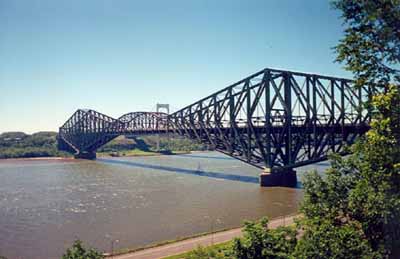Québec Bridge National Historic Site of Canada
Québec, Quebec

General view
(© Agence Parcs Canada / Parks Canada Agency, S. Desjardins, 1998.)
Address :
1675 des Hôtels Ave., Québec, Quebec
Recognition Statute:
Historic Sites and Monuments Act (R.S.C., 1985, c. H-4)
Designation Date:
1995-11-24
Dates:
-
1917 to 1917
(Construction)
Event, Person, Organization:
-
H.E. Vautelet
(Architect)
Other Name(s):
-
Québec Bridge
(Designation Name)
Research Report Number:
1995-060
Plaque(s)
Existing plaque: On grounds of Aquarium de Québec (north-east end of bridge) 1675 des Hôtels Ave., Québec, Quebec
This is the longest span cantilever bridge in the world, stretching 548.6 meters between the main piers. Completed in 1917, it is a remarkable engineering achievement. To overcome technical problems that had caused the collapse of an earlier span and the loss of 76 lives in 1907, Canadian engineers used nickel steel as a structural material and an innovative K-truss design. Designed and built by the St. Lawrence Bridge Company of Montréal, this impressive work is universally recognized as a symbol of engineering excellence.
Description of Historic Place
The Québec Bridge National Historic Site of Canada is a steel cantilever bridge which links the shores of Québec City and Lévis over the St. Lawrence River, located a few kilometres upstream from Québec City. Built in 1917 with a total length of 987 metres and a height of 95 metres, the bridge is comprised of north and south approach bays, anchor piles and arms, two main pillars resting on the river bed, cantilever arms, and a 500-metre suspended section between them. Official recognition refers to the bridge itself, its anchor pillars and the two main pillars on the river bed.
Heritage Value
The Québec Bridge was designated a national historic site of Canada in 1995 because: it is the longest clear-span cantilever bridge in the world, the first major bridge to use the K truss which greatly facilitated its erection, and the first bridge in North America to use nickel steel in its construction; a remarkable engineering feat, the Québec Bridge was largely conceived and built by Canadians.
The Québec Bridge, with its 500-metre free span between the two central pillars, is the longest cantilever bridge of its kind in the world. Built using the K truss system, in which two diagonal beams support one vertical beam (forming a ‘K’ shape), the bridge is also remarkable for the use of nickel steel in its construction. Although this stronger alloy was more expensive than the more popular carbon steel, it allowed engineers to attain the record-breaking length of the bridge’s suspended section.
The bridge was designed and constructed principally by Canadian companies under head engineer H.E. Vautelet. Its construction was facilitated by the K truss system, but also by the manner in which the suspended section was installed. Constructed separately, this section was floated on the river to the cantilever arms and raised, where it was riveted in place. Because of its size and innovative design, the Québec Bridge remains one of the most important bridges in the history of civil engineering in Canada, as well as an important symbol of Québec City.
Source: Historic Sites and Monuments Board of Canada, Minutes, November, 1995.
Character-Defining Elements
Key elements contributing to the heritage value of this site include: its location and setting over the St. Lawrence River, spanning the shores of Québec City and Lévis; its 500-metre span between abutments, the longest of its kind; its distinctive form, scale and massing, as expressed in its vertical and diagonal steel beams and masonry pillars; its linear footprint and geometric profile; its structure composed of approach bays, anchor piles, anchor arms, cantilever arms resting on masonry pillars and joined by a suspended section; the cantilever design of the bridge, including the K truss system with two diagonal beams supporting one vertical beam, all connected with rivets; the integrity of the materials used, including the carbon steel used for the bridge structure, anchor arms, cantilever trusses, and vertical compression pieces, the use of nickel steel on most of the tension pieces, as well as the masonry pillars; the integrity of its construction technology; its commemorative plaque near the north entry from Canadian and American Engineering Societies, designating the Québec Bridge as an international monument to civil engineering; viewscapes from both shores and from the bridge toward Québec City and Lévis.